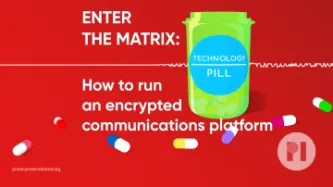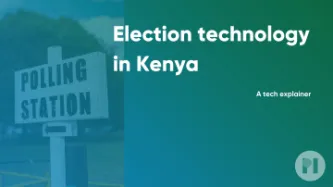Search
Content type: Advocacy
In August 2024 the UK College of Policing (CoP) announced they were consulting on new guidance for data ethics and data driven technologies in policing. As part of the consultation the College asked for feedback on two new authorised professional practices (APP) on data ethics and data-driven technologies. PI provided a response in writing to the CoP on their APP on data ethics and data-driven technologies only.In our response we highlighted that we are aware that UK police forces are using a…
Content type: Long Read
IntroductionHarnessing new digital technology to improve people’s health is now commonplace across the world. Countries and international organisations alike are devising digital health strategies and looking to emerging technology to help solve tricky problems within healthcare. At the same time, more and more start-ups and established tech companies are bringing out new, and at times innovative, digital tools aimed at health and wellbeing.
Content type: Long Read
IntroductionWith the ongoing expansion of GPS tagging under the UK Home Office's electronic monitoring programme, it has increasingly deployed non-fitted devices (NFDs) that track a person's GPS location and request frequent biometric verification in the form of fingerprint scans.The NFDs deployed by the UK Home Office are small handheld devices with a fingerprint scanner that record a person's location 24/7 (referred to as their trail data). They alert the person at random intervals throughout…
Content type: Long Read
1. What is the issue?Governments and international organisations are developing and accessing databases to pursue a range of vague and ever-expanding aims, from countering terrorism and investigating crimes to border management and migration control.These databases hold personal, including biometric, data of millions if not billions of people, and such data is processed by technologies, including Artificial Intelligence (AI), to surveil, profile, predict future behaviour, and ultimately make…
Content type: Video
Links for description: - Matrix- Element- Telegram's encryption- Blah- Anatel Brazil Whatsapp arrest- European commission 42 point going dark plan- Clipper chip: Listen to our podcast!- Online Safety Act- Liberty on the Online Safety Act- Adam Langley- More about Pond.org- 'We kill people based on metadata'- PI and ICRC report- Matrix P2P tracker- Alec Muffett v Matthew Hodgson- PI's take on the Digital Markets Act- Apple enable RCS- Chat Control- Cyber Resilience Act
Content type: Long Read
Elections and political campaigns are increasingly mediated by digital technologies. These technologies rely on collecting, storing, and analysing personal information to operate. They have enabled the proliferation of tailor-made political advertising. The recent proliferation of AI technologies is enabling ever more sophisticated content creation and manipulation in the context of elections.In parallel, governments are continuing to invest in digital technologies for the running of elections…
Content type: News & Analysis
Artificial intelligence decision making systems have in recent years become a fixture of immigration enforcement and border control. This is despite the clear and proven harmful impacts they often have on individuals going through the immigration system. More widely, the harms of automated decision making have been increasingly there for all to see: from systems that encode bias and discrimination, as happened in the case of an algorithm used to detect benefit fraud in the Netherlands, to…
Content type: News & Analysis
We’ve published a new tech explainer on election technologies in Kenya. The explainer takes a deep dive into the technologies employed to manage and administer the election process in Kenya, such as biometric voter registration (BVR), voter identification, results transmission, and candidate management systems.Electoral processes - along with elections themselves - are one of the largest government data-gathering exercises undertaken, making them susceptible to data exploitation and privacy…
Content type: Examples
Ontario allocates $30 million to install new security technologies and vape detectors, expanding their surveillance apparatus whilst contributing to an overall cut in funding per student. Some of the vape detectors installed in Canadian schools include noise detectors, however there is a lack of transparency in how data is collected or used, and evidence for their efficacy in keeping students safe is lacking. Link to article: https://theconversation.com/vaping-in-schools-ontarios-30-…
Content type: Advocacy
When it comes to elections around the world, we find ourselves in a terrain that is more and more populated by digital technologies, which have an increasingly critical impact upon the realisation of democracy. Digital technologies used in the context of elections offer new opportunities to support voter participation, whilst simultaneously posing increasing challenges for voters and those who manage and oversee elections. The introduction of technologies into electoral systems in countries…
Content type: Explainer
Many democracies, particularly younger democracies, are increasingly looking to employ technology - including biometrics - to coordinate the running of their electoral processes. Governments give various reasons for the use of these technologies, such as transparency, voter identification, and fighting corrupt practices in attempts to increase confidence in election results.
These databases and the devices used to access and edit them are susceptible to abuse, manipulation, and theft. Moreover…
Content type: Examples
The UK's Information Commissioner's Office (ICO) has reprimanded the Chelmer Valley High School in Chelmsford, Essex for unlawfully implementing facial recognition technology in its canteen. The school failed to perform a data protection information assessment, and didn't get adequate permission to process their students' biometric data or ask students to give consent by opting in. North Ayrshire Council - who implemented facial recognition in nine schools in Scotland - have also been warned by…
Content type: Examples
The UK's Department of Education intends to appoint a project team to test edtech against set criteria to choose the highest-quality and most useful products. Extra training will be offered to help teachers develop enhanced skills. Critics suggest it would be better to run a consultation first to work out what schools and teachers want.Link to article Publication: Schools WeekWriter: Lucas Cumiskey
Content type: Examples
The UK's new Labour government are giving AI models special access to the Department of Education's bank of resources in order to encourage technology companies to create better AI tools to reduce teachers' workloads. A competition for the best ideas will award an additional £1 million in development funds. Link to article Publication: GuardianWriter: Richard Adams
Content type: Examples
Google has settled a case brought in 2020 by the parents of an Illinois girl who sued the company in state court alleging that it had violated two sections of the Biometric Information Privacy Act. The case also alleged that Google had violated the law by failing to obtain parental consent to collect, store, and use biometric data belonging to millions of children and had illegally harvest other data such as physical location, website histories, personal contact lists, passwords, and…
Content type: Examples
Los Angeles schools superintendent Alberto Carvalho is appointing a task force to find out what went wrong and how to move forward with an AI chatbot intended to issue advice and create individual acceleration plans for every student. The company, AllHere, has apparently collapsed financially, but the school district still has no idea why. Its former manager, Chris Whiteley, has said the company implemented security and privacy in ways that violated school district policy, sound pracctice, and…
Content type: Examples
Teachers and staff members at state primary and upper primary schools across the Indian state of Uttar Pradesh are protesting the requirement that they use a digital attendance system to log their entry and exit times. Among the problems: the system was introduced without a trial period to solve problems and the portal allows only 15 minutes for taking attendance. They are refusing to use the system until other needs, such as earned leave and compensatory holidays when they have to work on…
Content type: Examples
The Utah State Board of Education has approved a $3 million contract with Utah-based AEGIX Global that will let K-12 schools in the state apply for funding for AI gun detection software from ZeroEyes for up to four cameras per school. The software will work with the schools' existing camera systems, and notifies police when the detection of a firearm is verified at the ZeroEyes control centre. The legislature will consider additional funding if the early implementation is successful. The…
Content type: Examples
The Los Angeles school district turned off “Ed”, a $6 million chatbot, after the company paid to develop it got into financial trouble. The incident provides a cautionary tale for Britain’s new Labour government, which has talked of using AI in schools to free up teacher time and revive public services on a tight budget, as has a report issued by the Tony Blair Institute. The failure of the algorithm used to predict GCSE and A-level grades during the covid lockdown and the potential to increase…
Content type: Examples
In an interview conducted by the Los Angeles Unified School District’s investigative team, Chris Whiteley, the former senior director of software engineering at AllHere, explained his concerns with the security and privacy aspects of the design of “Ed”, an AI chatbot intended to assist students. Whiteley says the chatbot placed students’ personally identifiable information at risk by including it in all chatbot prompts, even when the data wasn’t relevant. District leaders need to conduct…
Content type: Examples
The United School Administrators of Kansas, who represent more than 2,000 administrators in the state, are partnering with Seattle-based Indicio to install its Indicio Proven product, which will issue and verify transcripts and other records with ID verification.Link to articlePublication: Biometric UpdateWriter: Joel R. McConvey
Content type: Examples
Los Angeles public schools have turned off an AI chatbot custom-designed to help parents and children navigate the school system after only three months because AllHere, which created it, mostly shut down. The information the chatbot dispensed is still available on the school’s platform, and the district intends to bring it back once officials figure out how to proceed. The school’s contract was worth $6 million over five years; about half it had been paid.
Link:LAUSD shelves its hyped AI…
Content type: Examples
Public documents show that US school districts have for years been buying phone cracking tools from companies like Cellebrite and Oxygen Forensics. The equipment enables school district employees to search students’ personal devices. In one example, the Los Angeles Unified School District says its team uses its Cellebrite device to investigate complaints about employee misconduct against students. Many questions remain about how these devices are used: what justification is needed for searches…
Content type: Examples
Schools in Hyderabad, the capital of the Indian state of Telangana, are using facial recognition to take morning attendance. Telangana is also using facial recognition to pay pensions, renew driving licences, evoting, and deter crime. Adoption was partly fueled by fear of spreading covid-19 through fingerprints. There are now 370,000 cameras in Hyderabad, controlled from a new command-and-control centre, and about 925,000 across Telangana. Link to the article Publication: The…
Content type: Examples
The United School Administrators of Kansas, who represent more than 2,000 administrators in the state, are partnering with Seattle-based Indicio to install its Indicio Proven product, which will issue and verify transcripts and other records with ID verification.Link to articlePublication: Biometric UpdateWriter: Joel R. McConvey
Content type: Examples
The Delhi government is expected to introduce facial recognition in schools in order to improve attendance, which is hovering at 65-70%. The government also proposes to provide parents with monthly attendance reports and introduce monthly and weekly tests in order to keep students engaged. Educators say that the solution to failing should be pedagogical rather than administrative. Link to the article Publication: Indian ExpressWriter: Vidheesha Kuntamalla
Content type: Examples
A paper links depth of semantic encoding (which is important for reading comprehension) to reading text on paper rather than on a screen. This link was made after studying high-density EEG (which records brain activity) while 59 middle school students completed single-word semantic judgment tasks after reading passages of text. Link: Middle-schoolers’ reading and processing depth in response to digital and print media: An N400 studyPublication: BioRxivPublication date: 2023-09-01Writer:…
Content type: Examples
With the use of ChatGPT already well established among students technology companies are coaching teachers on using AI tools to save substantial time on tasks such as grading, providing student feedback, and planning lessons, which reports say take up to 50 hours a week. Teachers are uncertain; planning lessons is one of the more creative parts of the job, and students crave human feedback. Link to the article Publication: MIT Technology ReviewWriter: James O'Donnell









